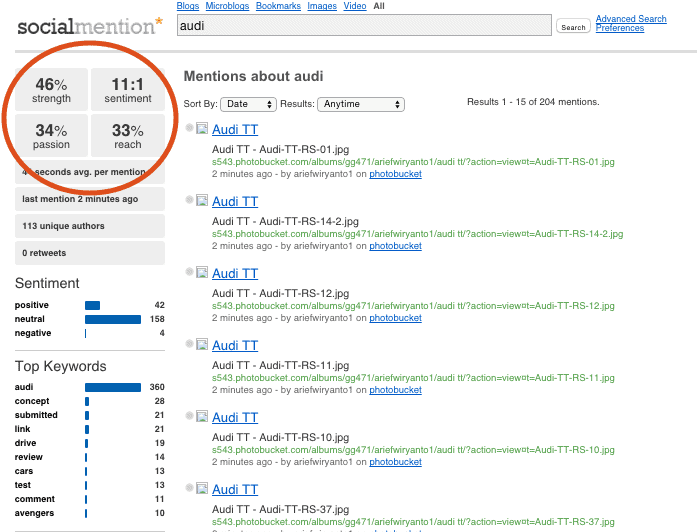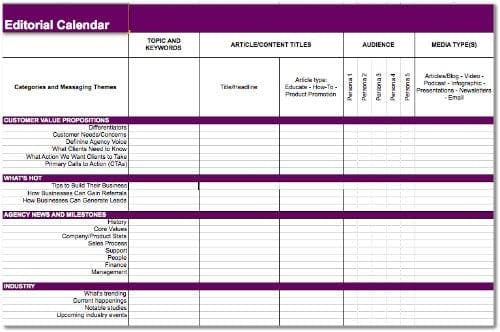Are you using social media to market your business, but struggling to create momentum? You need an effective social media business plan!If you want to make sense of each social network, define where you show up, and how to spend your time online, this is your roadmap.While there are no one-size-fits-all solutions, you can succeed with the right plan in place.Ready to get started? Let's dive in.
Why Create a Social Media Business Plan?
Lewis Carrol said,
"If you don't know where you are going, any road will get you there."
And just as in life, the same holds true in social media.If you don't know where you're going -- you're almost surely going to get there.With a social media business plan, you act on purpose.This customized strategy - one specific to your business - guides you towards defined goals.Not sure where to begin?Below are eleven tips to help you craft your social media business plan and take full advantage of all that social media has to offer.
11 Essential Elements of an Effective Social Media Business Plan
1. Track Your Starting Point
There's no way to know how far you've come if you don't know where you started.Your first step is tracking your starting point. Identify where you are today - how you appear online - and capture that in an Excel sheet, Word or Google doc.
Here are a few things you're looking for:
- How often does your website show up in search? Go to Google and type site: www.yourwebsite.com (replace the URL of your web site for www.yourwebsite.com), look at the top of the page, above the search results and below the menu and you will see a count of the number of search results. Write down this number which shows how many pages from your website are indexed by Google.
- How often do you show up in search? Go to Google and type your name in quotes. For example: “Rebekah Radice.” You're looking for an exact match. The number you see at the top is the one you want. Write it down.
- How often does your company show up in search? Go to Google and type your company name in quotes, followed by the word "and," (not in quotes), and the words city and state in quotes and separated by a comma. For example: “RadiantLA” and “Los Angeles, California." See the number in the top left corner and write it down.
- Check sites like www.WooRank.com and www.SemRush.com for competitive data and insight into how well your site is performing.
- Go to each social network and write down the following metrics for each channel. You're tracking growth, engagement, and conversation around your brand monthly. You can do the same for any competitors you'd like to track as well.
Social Media Metrics to Track
In his viral article, Avinash Kaushik explains the critical metrics all social marketers must track. The beauty in this is the complete obliteration of anything vanity - meaning, you will not track followers, fan numbers, or other meaningless metrics.Here's a breakdown of what you need to begin tracking today.
Conversation Rate
More than just mentions, your conversation rate helps you see the average number of comments per post in comparison to your number of followers or fans.Go to Facebook, Twitter, Pinterest, Instagram, and LinkedIn to get started. Write down how many comments your content received over the last week. Now divide that number by your total number of fans or followers, then multiply by 100.You can look at your posts separately or use the general metrics in your Analytics/Insight section.
Amplification Rate
Rather than looking at each share rate separately, the amplification rate takes a holistic approach.By tracking amplification, you'll see how your content is showing up across all networks.To track this, write down the number of re-pins, retweets, or shares of your content during the last week. Now divide that number by your total number of fans or followers.
Applause Rate
The applause rate helps you see what content your audience shares. The calculation is based on each post's number of "likes" (retweets, pins, etc.).To begin, go to each social network and write down the average number of likes per post.Now divide that number by your total number of fans or followers, then multiply by 100.The goal is to grow your online presence organically through social media. The more you share content, the more you interact online, and the more your audience (and search engines) begin to take notice.

2. Know Your Audience
Before you hop on Facebook, Twitter, LinkedIn, YouTube or Instagram - get hyper-focused on your audience.Who is your target market? Understand their area of expertise, what they're talking about online, and how you'll use content to make a connection.You'll also want to do an online audit of your competition to see how (or if) they've reached your target audience and where opportunities still lie.The key here is to cater your content to the specific needs of your audience. Write for your reader, not you, and not based on assumptions of what you think you know.Stop trying to be everything to everyone.
3. Choose Your Social Network(s)
Social networks such as Facebook, Twitter, and Instagram open the door to conversation.But while many believe you need to spread yourself out on each channel above, I disagree.Instead, identify where your target market is spending time online and then master that network.Create an action plan designed with that network and audience in mind.For example, if you've decided on Pinterest - what is your audience pinning? What content can you pin to attract their attention?To get started, your plan of action might look something like this...
Sample Action Plan: Pinterest
- Create 12 new boards with Pinterest board names based on keyword research - make them descriptive, optimized and enticing
- Pin 2-3 pieces of content from blog, website, Facebook, and others on a daily basis
- Follow 10 relevant people and/or brands that pin similar content
- Re-pin 2-3 pieces of their content daily to increase awareness
- Design or pin eye-catching images with the possibility of “going viral”

4. Be a Valuable Resource
Want to become a valuable resource to your community?Share relevant, thoughtful, interesting and educational content - and share it often.Become a giver. This is the best way to establish thought leadership and position you as an expert within that field.As Eric L. Mitchell says,D
Do we really need to be rewarded for everything? Give to give!
5. Monitor the Chatter
While social media is an excellent communication tool, it's also an invaluable listening tool.As you listen to your customers, take time to truly hear what their needs, wants and desires are.Then work to fulfill those needs and wants with your content, time, compassion and genuine feedback.
Use tools like:

6. Establish Rhythm, Tone, and Voice
To attract the right people online, you need to get real.As you begin to share content, identify how to best translate your authentic voice across social media.What does this look like?If you're playful, let that shine through. If you're serious, keep that tone in your writing.People do business with those they know, like, and trust.Trust erodes quickly when you're putting on an act and pretending to be something you're not.
7. Create a Consistent Schedule
The only way to build a solid social media following is to stay in the conversation.Create a schedule to consistently share and engage daily.Determine what, how, and where of your social media strategy.
- How will you share?
- What will you share?
- Where will you share?
Break this down into a content calendar with a separate column for Facebook, Twitter, Google+, LinkedIn, Pinterest and Instagram, with an example of which type of media you will share.

8. Use the Right Tools
With the daily barrage of streaming content, it can feel overwhelming to keep up and manage a social media presence.That's where the right tools come in.They can take the overwhelm out of actively monitoring and engaging across various social networks.
Two of my favorites:
My daily management tool is Agorapulse.com. I can listen in on a conversation (keyword monitoring), engage in the conversation, and queue my content for the best times to post.It simplifies my life and streamlines communication.

It's no secret that I'm a huge fan of Pinterest. Tailwind is my go-to tool for data, analytics, and analysis.If you're spending any time on Pinterest, you need Tailwind!
With it, you can:
- Publish content
- Find relevant content to share
- Identify trending pins
- Check profile performance
- Track popular boards and much more!
9. Be an Expert Networker
Have you ever walked into a networking event and immediately started shouting details about your business? Of course not. Can you imagine what the response might be?I would think most would turn and walk away. Why? No one is interested in being sold.They want to get to know you, and they need to know that you’ve taken an interest in who they are.The problem is that most people show up on any social networking site screaming about their business.Stop showing up on social media to throw up, and instead start connecting in a meaningful (and productive) way.
10. Be a Relationship Collector
While we don’t collect business cards online, we collect fans and followers.But what are those fans and followers worth if you're not investing in the relationship?Dr. Ivan Misner, the Founder & Chairman of BNI, the world’s largest business networking organization, says you only need four referral sources to succeed.
Top Referral Sources
- Staff members – because no one understands your product or service better than someone who works for you
- People you have given referrals to in the past
- Anyone who has given you a referral in the past
- Your community – people connected to you and already know, like, and trust you.
Engage your top referrers and help them share your story. There’s nothing better than a third-party referral that can edify you and your business.Make a commitment to stop collecting, and start contributing. It’s the relationships, not the numbers, that matter.
11. Track, Measure and Adjust
Are you wishing for social media success, or are you planning for it?Put a plan in place that allows you to track, measure, and assess your results.
An example of metrics to track:
- Traffic referrals from each social network
- Leads from social channels to a specific landing page
- Engagement across social media - retweets, comments, likes
- Social media audience/community growth
- New blog subscribers
Once you've implemented a system to measure your success, you now need to analyze your progress.Identify what is working and adjust what is not. A successful social media strategy is agile.
BONUS: Get Blogging
Social media can be an enormous boost to online credibility, but it cannot replace the value a blog brings to your business and personal brand.It should be part of an integrated marketing plan. Not sure where to begin? Watch this short video to set up your blog in a few minutes.
Then get that content into a tool like Agorapulse.com. Spread your content across your social channels consistently without lifting a finger!
About Rebekah Radice
Rebekah Radice, co-founder of BRIL.LA, has traded narcissism for purpose. When not driving growth, you'll find her tricking family into thinking she's Emeril Lagasse - likely covered in marinara. The spotlight was fun, but impact is better. These days she's using 20+ years of brand brilliance for good.
